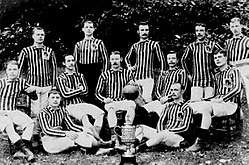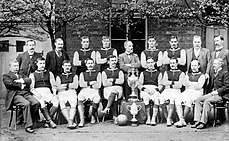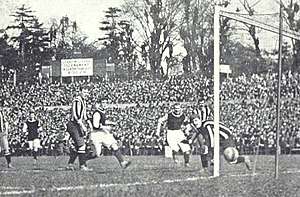History of Aston Villa F.C. (1874–1961)
Aston Villa F.C. were formed in March 1874, by four members of the Villa Cross Wesleyan Chapel (known as early as 1867 as Aston Villa Wesleyan Chapel)[1][2] in Lozells. The four founders were Jack Hughes, Frederick Matthews, Walter Price and William Scattergood. The first match was against the local Aston Brook St Mary's Rugby team.[3][4] As a condition of the match, the Villa side had to agree to play the first half under rugby rules and the second half under football rules. The club were soon playing the modern version of football though and the club won its first FA Cup in 1887.[5] Aston Villa were one of the dozen teams that competed in the inaugural Football League in 1888 with one of the club's directors, William McGregor being the league's founder. Aston Villa emerged as the most successful English club of the Victorian era. By the end of Villa's "Golden Age" at the start of the First World War, the club had won the League Championship six times and the FA Cup five times.[5]


Aston Villa won their sixth FA Cup in 1920.[5] For the remainder of the inter-war years though, Villa were on a slow decline that would lead to them being relegated to the Second Division in 1936 for the first time in their history. They returned to the top-tier of English football by the outbreak of the Second World War. As with many clubs, the war brought much change to Villa Park and remainder of the 1940s were spent rebuilding the team. By 1957, Villa were a Cup winning side once again with the club's seventh FA Cup win. Even though Villa won the inaugural League Cup in 1960, the club were to enter into a very unsuccessful period. The 1960s saw much change at Villa Park. By the end of the 1960s, Villa were languishing in the Second Division and fan pressure led to the resignation of the Board and the introduction of Doug Ellis as Villa Chairman.[6][7]
Formation by Villa Cross Cricketers
Club folklore has it that Aston Villa Football Club was formed by four players from the Villa Cross Wesleyan Chapel cricket team. It is said that they "met in 1874 under a gas-light in Heathfield Road"[3] to set about forming a new club. They were looking for something to keep them occupied during the winter. The club's official history states that they chose football after witnessing an "impromptu game on a meadow off Heathfield Road".[3] The four founders of Aston Villa were Jack Hughes, Frederick Matthews, Walter Price and William Scattergood. Their first match was played against the local Aston Brook St Mary's Rugby team on Wilson Road, Aston.[4] As a condition of the match, the Villa side had to agree to play the first half under rugby rules, and the second half under football rules. The game was a scoreless draw at half time but Jack Hughes scored a goal in the second half to ensure that Villa won their first ever game.[3] Villa moved to their first official home, Wellington Road in Perry Barr, in 1876 after their captain, George Ramsay, noted that in order to progress, Villa would need to move into an enclosed ground to be able to collect gate money.[8] The site was taken on a three-year lease at a rent of £7,10 shillings for the first year, rising to £15 and £20 in subsequent years. By the late 1870s, Villa were improving greatly and by 1880, Villa won their first senior honour when they won the Birmingham Senior Cup under the captaincy of Scotsman Ramsay.[9]
Rise to prominence

The club won its first FA Cup in 1887, under the captaincy of another Scotsman, Archie Hunter.[10] They beat West Bromwich Albion 2–0 in the final held at The Oval.[3] Up until 1885, football had remained an amateur sport. It turned professional in 1885, when the FA legalized professional football, but with a national wage limit. However, the Scottish draper and director of Aston Villa, William McGregor had become frustrated with watching his team in one-sided friendly matches and low attendances for all games but FA Cup ties.[11] He saw that in order to keep interest in the game alive, the top teams needed to play each other in a league much like American baseball teams did. McGregor wrote to the twelve leading clubs in England proposing the formation of a league, what would later be known as the English Football League. Aston Villa were one of the dozen teams that competed in the inaugural Football League in 1888. Villa's first League game came on 8 September 1888, when they drew 1–1 Wolverhampton Wanderers as Tom Green scored the club's first League goal. Villa finished runners-up to Preston North End in that inaugural season.[12]
Victorian and Edwardian eras

It did not take long for Villa to lift their first League Championship trophy, and this was achieved in 1893–94.[5] Villa were soon attracting large crowds; the club could regularly expect 25,000 people to attend home games. This was at a time when the FA Cup Final would attract only about 20,000. With poor spectator facilities and an uneven pitch, the Wellington Road ground was increasingly unsuitable,[13] and in 1897 Villa's financial secretary Frederick Rinder negotiated the purchase of their current home ground, the Aston Lower Grounds.[14] In the 1899–1900 season Billy Garraty became the top goalscorer in world football scoring 27 goals in just 33 league games and a total 30 goals in 39 league and cup games. The name of Villa Park was not used until about 1900. It came about through fan usage and no official declaration was made that listed the name as Villa Park.[14] The ground was not purchased outright until 1911.[15]

Villa began the 20th century as champions but the gap that distinguished them from their competitors was diminishing. Football in England was becoming more competitive as more teams formed. Villa did remain a significant force in the game though. Despite a run of four victories at the start of the 1900–01 season, Villa finished fourth from bottom. In the 1902–03 season Villa won 12 of their last 15 games to finish only one point behind champions Sheffield Wednesday. In 1905, Villa won the FA Cup with a then record crowd of 101,117 watching the match at Crystal Palace, where Villa beat Newcastle United 2–0.[15] In the same season, Villa finished fourth and this helped to boost the coffers at the club. After the success of 1905, Villa went through a barren patch and it was not until the 1909–10 season that Villa threatened to regain the title. In that season, they beat the reigning champions Manchester United 7–1. Villa won the championship for the first time in 10 years to take a then record, sixth title.[15] The 1910–11 season was very close and the title was decided on the last day of the season when Villa lost to Liverpool and Manchester United beat Sunderland to take the title. The following season, Villa finished sixth. Yet in 1913, Villa won the FA Cup for a then record-equalling fifth time.[15] By the end of what was to be called Villa's golden era,[15] when the First World War began, the club had won the League Championship six times and the FA Cup five times.[5] This included the League and Cup Double in 1896–97, a feat which would not be repeated for more than 60 years.
Inter-war years
Football resumed after the war for the 1919–20 season and Villa won their sixth FA Cup at the end of season, beating Huddersfield Town 1–0 at Stamford Bridge. In November 1923, Villa's centre-half Tommy Ball was killed by his neighbour, thus becoming the only active Football League player to have been murdered.[16] In their Golden Jubilee season of 1923–24, Villa got through to the second final to be held at the then new Wembley Stadium, where they lost 2–0 to Newcastle United. This Cup final was to be something of a pinnacle though as Villa then had League finishes of sixth and tenth in the following seasons. The Directors attempted to stop the slump with transfer dealings. In 1927, they bought both Jimmy Gibson and Eric Houghton. In 1928, they bought in one of the most prolific goalscorers to have ever played in the English football league. When Villa signed Tranmere Rovers striker Tom Waring for £4,700, he was relatively unknown. Waring scored a record 49 league goals in the 1930–31 season as Villa finished runners-up to Arsenal. One of the other purchases, Eric Houghton, scored 30 goals.[15]
The team were playing well and scoring many goals. In the 1933–34 season, Villa had no fewer than fourteen full internationals and they continued to challenge for honours being second in the League in 1933. Yet this success did not last and the complacency at Villa Park led to a slump in form.[15] This slump culminated in their relegation from the first tier of English football for the first time in their history in the 1935–36 season. The relegation coincided with the decision to appoint their first manager. Before the 1935–36 season, the team had been appointed by a committee and the team was coached by a "secretary" to the committee.[9] The relegation though was largely due a dismal defensive record, they conceded 110 goals, 7 of them coming from Arsenal's Ted Drake in a 1–7 defeat at Villa Park. Villa came ninth in their first season in the Second tier of English football but they were crowned Second Division Champions in 1937–38 under the guidance of Jimmy Hogan. By the outbreak of the Second World War, Aston Villa were back in the top-flight of English football.[17]
Their Aston Villa reserves (or seconds) team enlisted in the army and were captured at the Dunkirk evacuation in June 1940. In December in an Eastern German camp, a German Guard regiment challenged British prisoners of war to a game of football; the guards were being defeated 27–0 when they stopped the game, only then learning these prisoners were Aston Villa's second team.[18]
Post-war rebuilding
For Villa, as with all English clubs, the Second World War brought about the loss of seven seasons, and several careers were brought to a premature end by the conflict. The first game played at Villa Park after the cessation of hostilities was against Middlesbrough and Villa lost 1–0 in front of a crowd of 50,000.[19] Aston Villa went about rebuilding the team, under the guidance of former player Alex Massie for the remainder of the 1940s. Massie made some bold signings in his time with the club, the first of which was 23-year-old Wales international Trevor Ford, who was bought from Swansea for £9,500 in 1946, when Villa finished eighth in the League. Ford would go on to score 60 times in his four seasons at Villa Park, before he was sold in the 1950–51 season to Sunderland for a then British record of £30,000 (£1,000,000 today).[20][21]
For the remainder of the 1940s and early 1950s, Massie continued to bring in new players whilst the team regularly had mid-table finishes. One of the more influential signings was Danny Blanchflower in 1951 for £15,000. Villa had a good start to the 1951–52 season when, after eight games, Villa were second behind Manchester United. This was their best start of the last 19 years, and they eventually finished in sixth place. After a mid-table finish in the 1952–53 season, the following season, saw the return of Eric Houghton, this time in a managerial capacity. One of his first actions was to introduce 19–year–old Peter McParland to the first team. His first season in charge ended with Villa in 13th place. Nevertheless, "Houghton had done well to guide a transitional Villa team to a respectable position in the top flight."[19] Under Houghton's stewardship, Villa won the 1957 FA Cup Final against Manchester United's celebrated Busby Babes. Peter McParland scored both goals in a 2–1 victory, in a record-equalling ninth FA Cup final.[19] It was Aston Villa's first trophy for 37 years.[5]
Fluctuating fortunes
The success of the previous season proved to be something of a false dawn though, with the team finishing 14th, seven points above relegation. After refusing to resign, Eric Houghton was sacked when relegation seemed imminent in 1958–59. His successor Joe Mercer was unable to prevent the club being relegated in 1959, for only the second time in its history. The fact that Villa reached the semi-finals of the FA Cup only served to highlight the complacency that had set in at the club that led to Villa being relegated. Villa only spent one season in the Second Division, returning as Champions in 1960. The 1960–61 season was a successful one; it saw Villa reach the semi-finals of the FA Cup, finish ninth in the League, and win the inaugural League Cup.[19] This was helped by the emergence of an exciting group of youth players, who became known as "Mercer's Minors".[22]
References
- Specific
- The Times Marriages 4 January 1867
- "Birmingham Mail - Wednesday 24 October 1883". www.britishnewspaperarchive.co.uk. Retrieved 17 March 2020.
- "Villa History 1874 – 1887". AVFC.co.uk. Archived from the original on 5 April 2006. Retrieved 26 June 2007.
- Hayes p. 183.
- "Club Honours". AVFC.co.uk. Retrieved 18 April 2011.
- "Ellis awarded New Year accolade". BBC Sport. 31 December 2004. Retrieved 2 October 2007.
- "Doug Ellis reveals". BBC Sport. 30 November 2006. Retrieved 2 October 2007.
- "Archived copy". Archived from the original on 4 March 2016. Retrieved 8 October 2015.CS1 maint: archived copy as title (link)
- Hayes p. 135.
- "FA Cup results – 1887". English Football Archives. Archived from the original on 11 May 2006. Retrieved 24 September 2007.
- "The Old Firm: give them a profitable dose of competition in England". IEA. Archived from the original on 27 September 2007. Retrieved 24 September 2007.
- "Club History 1888 – 1899". AVFC.co.uk. Archived from the original on 24 August 2006. Retrieved 24 September 2007.
- Paul Smith & Shirley Smith (2005) The Ultimate Directory of English & Scottish Football League Grounds Second Edition 1888–2005, Yore Publications, p143, ISBN 0954783042
- "Villa Park History". Villa fans Almanac. Archived from the original on 29 September 2007. Retrieved 2 July 2007.
- "Aston Villa Club History 1900 – 1939". AVFC.co.uk. Archived from the original on 24 August 2006. Retrieved 28 October 2007.
- Cowan, Mark (6 May 2010). "The star Villa player shot dead by neighbour". Birmingham Mail. Archived from the original on 8 May 2010. Retrieved 3 November 2011.
- Hayes p. 144–145.
- Associated Press, "The city's ordeal by fire" (page 5), The Times, 31 December 1940. Retrieved 3 May 2015.
- "Villa History 1946 – 1949". AVFC.co.uk. Archived from the original on 24 August 2006. Retrieved 29 September 2007.
- Days, p 169.
- Hayes p. 67.
- "A Villa Fan's Memoirs". John Lerwill. Retrieved 29 September 2007.
- General
- Hayes, Dean (2 October 1997). The Villa Park Encyclopedia: A-Z of Aston Villa. Mainstream Publishing. ISBN 978-1-85158-959-3.
- Holt, Frank Lee; Bishop, Rob (2010). Aston Villa: The Complete Record. Derby: Derby Books Publishing. ISBN 1-85983-805-7.
- Ward, Adam; Griffin, Jeremy (2002). The essential history of Aston Villa. Headline book publishing. ISBN 0-7553-1140-X.